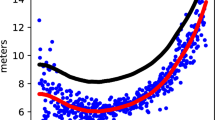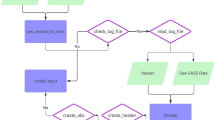Abstract
As an aid to survey design, we used data acquired from three European continuous GPS networks to test the precision of position estimates from static observations as a function of the length of the observing session and the number and distribution of reference stations. Our criterion was the weighted RMS of estimates over 31 days with respect to coordinates determined from 24-h sessions over a 2-year period. With a single reference station, a precision of 3 mm horizontal and 10 mm vertical could be achieved reliably only for session lengths of 3 h or longer and baselines less than 200 km. If four or more reference stations are used, these levels of precision were usually achieved with sessions as short as 2 h. With sessions 6 h or longer and four or more reference stations, the precision is typically 1–2 mm in horizontal and about 3–5 mm in vertical. Increasing the number of reference stations further provides only marginal improvement. Although there is some variation in precision in 4-station networks with the choice of reference stations, the dependence on distance and geometric distribution is weak.






Similar content being viewed by others
References
Altamimi Z, Collilieux X, Legrand J, Garayt B, Boucher C (2007) ITRF2005: a new release of the international terrestrial reference frame based on time series of station positions and earth orientation parameters. J Geophys Res 112:B09401
Blewitt G, Young LE, Meehan TH (1989) Sub-centimeter baselines within seconds using ROGUE receivers: introducing the rapid static survey (RSS) method. In: International association of geodesy conference, Edinburgh, August, 1989
Dong D, Herring TA, King RW (1998) Estimating regional deformation from a combination of space and terretrial geodetic data. J Geod 72:200–214
Dow JM, Neilan RE, Rizos C (2009) The international GNSS service in a changing landscape of globan navigation satellite systems. J Geod 83(3–4):191–198
Eckl MC, Snay RA, Soler T, Cline MW, Mader GL (2001) Accuracy of GPS-derived relative positions as a function of interstation distance and observing-session duration. J Geod 75:633–640
Frei E, Beutler G (1990) Rapid static positioning based on the fast ambiguity resolution approach (FARA): theory and first results. Manuscr Geod 15:325–356
Geng J, Meng X, Teferle RN, Dodson AH (2010) Performance of precise point positioning with ambiguity resolution for 1- to 4-h observation periods. Surv Rev 42:155–165
Hofmann-Wellenhof B, Lichtenegger H, Collins J (1997) GPS theory and practice. Springer, New York
Schwartz CR, Snay RA, Soler T (2009) Accuracy assessment of the national geodetic survey’s OPUS-RS utility. GPS Solut 13:115–132. doi:10.1007/s10291-008-01105-0
Soler T, Michalak P, Weston ND, Snay RA, Foote RH (2006) Accuracy of OPUS solutions for 1- to 4-h observing sessions. GPS Solut 10:45–55. doi:10.1007/s10291-005-0007-3
Zumberge JF, Helfin MB, Jefferson DC, Watkins MM, Webb FH (1997) Precise point positioning for the efficient and robust analysis of GPS data from large networks. J Geophys Res 102(B3):5005–5017
Author information
Authors and Affiliations
Corresponding author
Rights and permissions
About this article
Cite this article
Firuzabadì, D., King, R.W. GPS precision as a function of session duration and reference frame using multi-point software. GPS Solut 16, 191–196 (2012). https://doi.org/10.1007/s10291-011-0218-8
Received:
Accepted:
Published:
Issue Date:
DOI: https://doi.org/10.1007/s10291-011-0218-8




